Posted by: Northwest Eye in General on October 19, 2025
Overview
Coloboma eye is a congenital condition that can be concerning, as it is characterized by the absence of normal tissue in one or more parts of the eye. This condition may lead to varying degrees of vision impairment, depending on which structures are affected. We understand that learning about this can be overwhelming, but it’s important to know that early diagnosis and management can make a significant difference in outcomes.
This condition arises from the incomplete closure of the optic fissure during fetal development. We emphasize the importance of early intervention, as options such as vision correction and surgical procedures are available to help improve your vision. Remember, you are not alone in this journey; many have faced similar challenges and found effective solutions.
If you or a loved one is affected, we encourage you to seek care and support. It’s common to feel anxious about the future, but with the right guidance and resources, there is hope for a brighter outcome. We are here to help you through this process, ensuring that you have the support you need every step of the way.
Introduction
Coloboma eye, a congenital condition marked by the absence of normal tissue in various parts of the eye, presents unique challenges for those affected. We understand that navigating this condition can be daunting. As our understanding of coloboma evolves, individuals and families are seeking clarity on symptoms, causes, and treatment options to help them through their experiences.
What happens when the optic fissure fails to close during fetal development? It’s common to feel overwhelmed by the implications this may have on vision and daily life. Delving into the complexities of coloboma reveals not only its diverse manifestations but also the pathways to effective management and support. We are here to help you through this process, ensuring you feel informed and supported every step of the way.
Define Coloboma: An Overview of the Condition
Coloboma eye is a congenital condition that can be concerning, characterized by the absence of normal tissue in one or more parts of the eye, affecting structures such as the iris, retina, choroid, or optic nerve. This defect occurs during embryonic development when the optic fissure fails to close completely, typically between the fifth and seventh week of pregnancy. We understand that hearing about such conditions can be overwhelming, and it’s important to know that a coloboma eye can be unilateral, impacting one eye, or bilateral, affecting both. Approximately 67% of cases are unilateral, and their severity can vary significantly.
The impact on vision largely depends on the location and extent of the missing tissue. For instance, an iris defect may lead to a distinctive keyhole or cat-eye shape of the pupil, often accompanied by light sensitivity and glare. Recent studies indicate that the coloboma eye occurs in about 1 in 5,000 live births, with a broader global prevalence ranging from 0.5 to 7.5 per 10,000 births. It’s common to feel anxious about these statistics, but understanding them can help in managing expectations. Notably, the yearly occurrence of eye abnormalities is estimated at 2.4 per 100,000 individuals under 19 years of age.
Real-life examples demonstrate the varied effects of this condition. Some individuals with isolated iris anomalies maintain good vision, while others with more severe types, such as chorioretinal defects, may experience significant visual impairment. Additionally, associated conditions such as strabismus and amblyopia are prevalent, affecting 30% and 33% of patients, respectively. We are here to help you through this process, and grasping the complex characteristics of this condition, which involves at least 39 identified genes, is essential for accurate diagnosis and treatment.
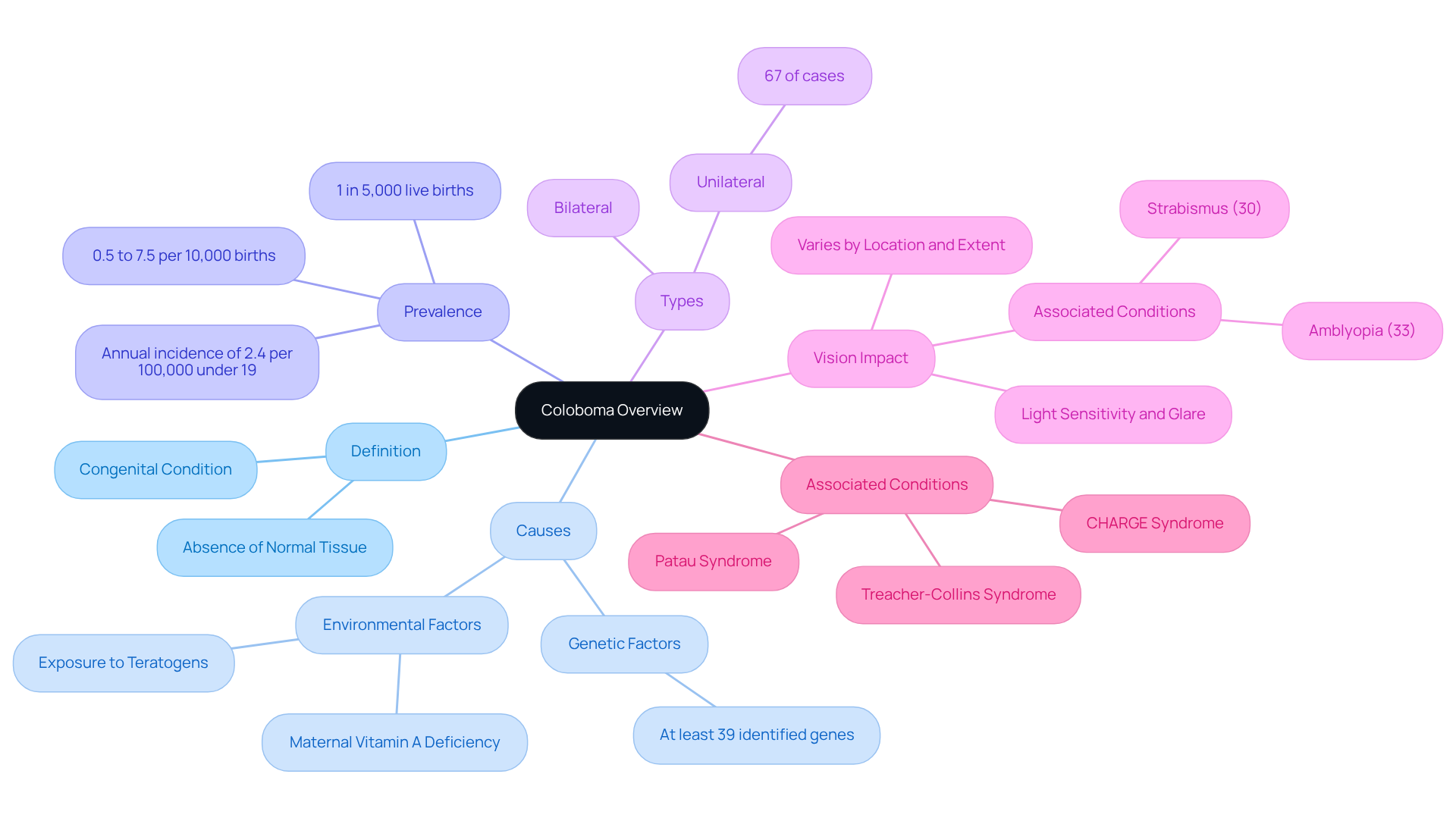
Identify Symptoms: Recognizing Coloboma in Patients
Symptoms of this eye condition can vary significantly depending on the specific eye structure affected. We understand that noticing changes in your vision can be concerning, and we want to provide you with the information you need. Common manifestations include:
- Light Sensitivity: Many individuals experience increased sensitivity to bright lights, which can lead to discomfort. Photophobia can often be alleviated by using tinted glasses, both indoors and outdoors, offering some relief and comfort.
- Keyhole or Cat-Eye Pupil: A hallmark of iris anomaly is the distinctive appearance of the pupil, resembling a keyhole or cat-eye shape, which is often noticeable at birth. This unique feature can be alarming, but understanding it is the first step towards managing your condition.
- Vision Impairment: The degree of vision impairment can vary from slight disturbances to significant vision loss, affected by the severity and position of the ocular anomaly. Approximately 90% of individuals with a coloboma eye may experience some form of visual acuity abnormalities. In certain cases, a coloboma eye can lead to total blindness in the affected eye, which can be daunting to consider.
- Nystagmus: Some patients may exhibit involuntary eye movements, known as nystagmus, which can complicate visual processing. It’s common to feel frustrated by these symptoms, but support is available.
- Other Visual Disturbances: Additional symptoms may include blurred sight or blind spots, particularly if the retina or optic nerve is involved. Coloboma eye conditions that affect the retina can lead to upper visual field defects and increase the risk of retinal detachment, a serious condition that can result in permanent vision loss if not treated promptly.
Recognizing these symptoms early is crucial for effective management and intervention. We want to emphasize the importance of comprehensive eye assessments to detect the condition, particularly in infants. Early diagnosis can greatly influence treatment results and provide peace of mind. As Daniel Porter mentioned, “The symptoms of this condition depend on where it occurs.” We are here to help you through this process.
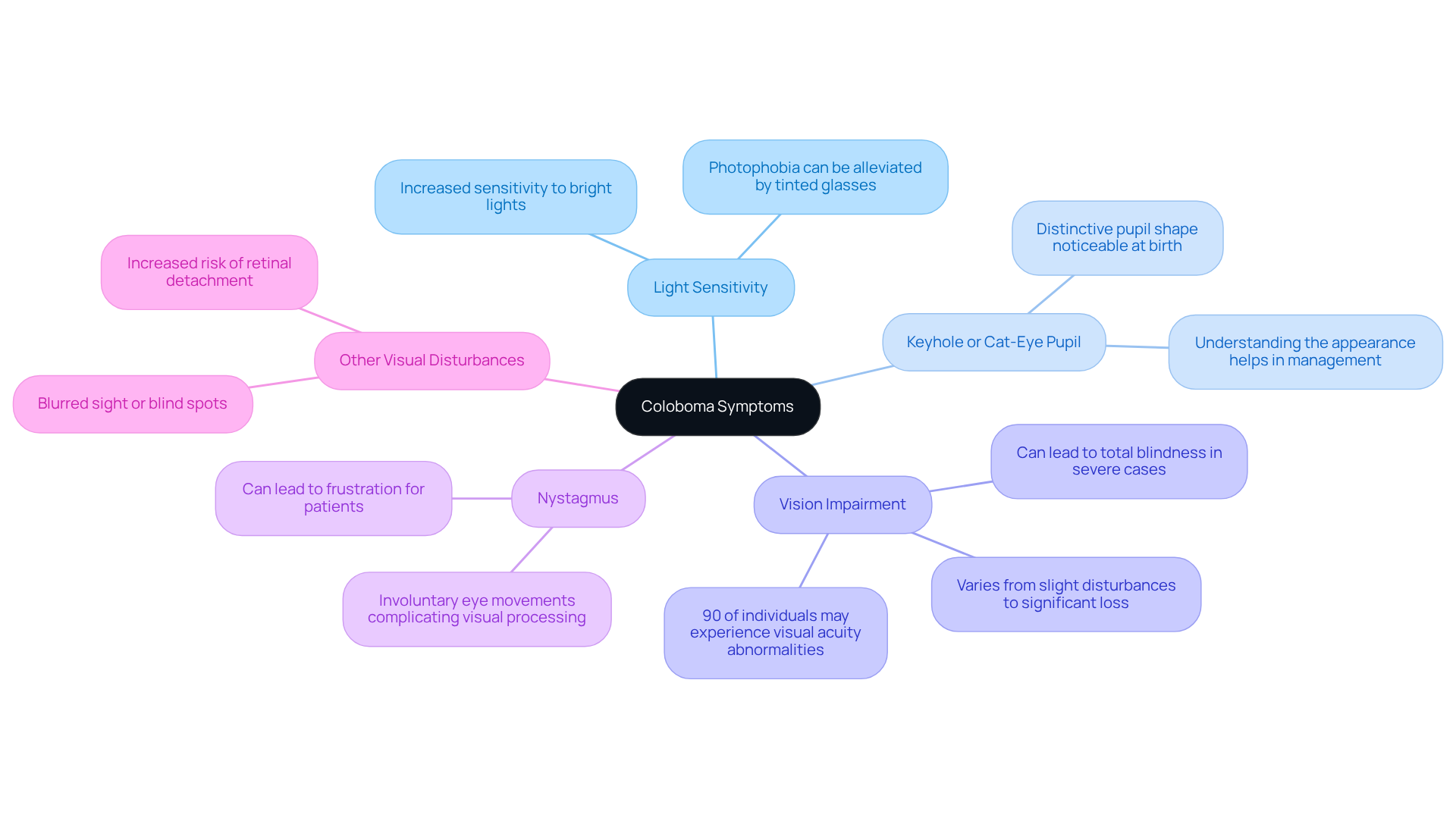
Explore Causes: Understanding the Origins of Coloboma
The condition known as coloboma eye arises primarily from the incomplete closure of the embryonic optic fissure during fetal development, typically around the 22nd day of gestation. We understand that learning about this condition can be concerning, and it’s important to know that genetic factors play a crucial role in its development. Several syndromes are linked to coloboma, including:
- Cat Eye Syndrome: This syndrome is notable for a vertical coloboma in the iris, which can be distressing to families.
- Patau Syndrome: Defined by an additional chromosome 13, this genetic condition is frequently associated with eye defects among other abnormalities, and we recognize the challenges it presents.
- CHARGE Syndrome: A complex genetic condition, CHARGE includes a specific eye abnormality along with other significant health issues, which can understandably raise concerns.
- Treacher-Collins Syndrome: This condition can also feature a specific eye defect affecting facial and ocular development, adding to the emotional weight for those affected.
Environmental factors also play a significant role in the risk of developing the coloboma eye condition. Teratogens, such as maternal drug use and nutritional deficiencies during pregnancy, have been implicated. For instance, research shows that a lack of vitamin A during pregnancy is linked to a higher chance of congenital eye abnormalities, occurring in about 1 in 10,000 individuals. We understand that this information can be overwhelming, but it’s crucial to know that exposure to specific medications, such as methimazole and thalidomide during pregnancy, can also result in eye malformations.
Understanding these multifaceted causes is essential for genetic counseling and risk assessment for affected families. We are here to help you through this process, providing support and information to navigate your concerns.
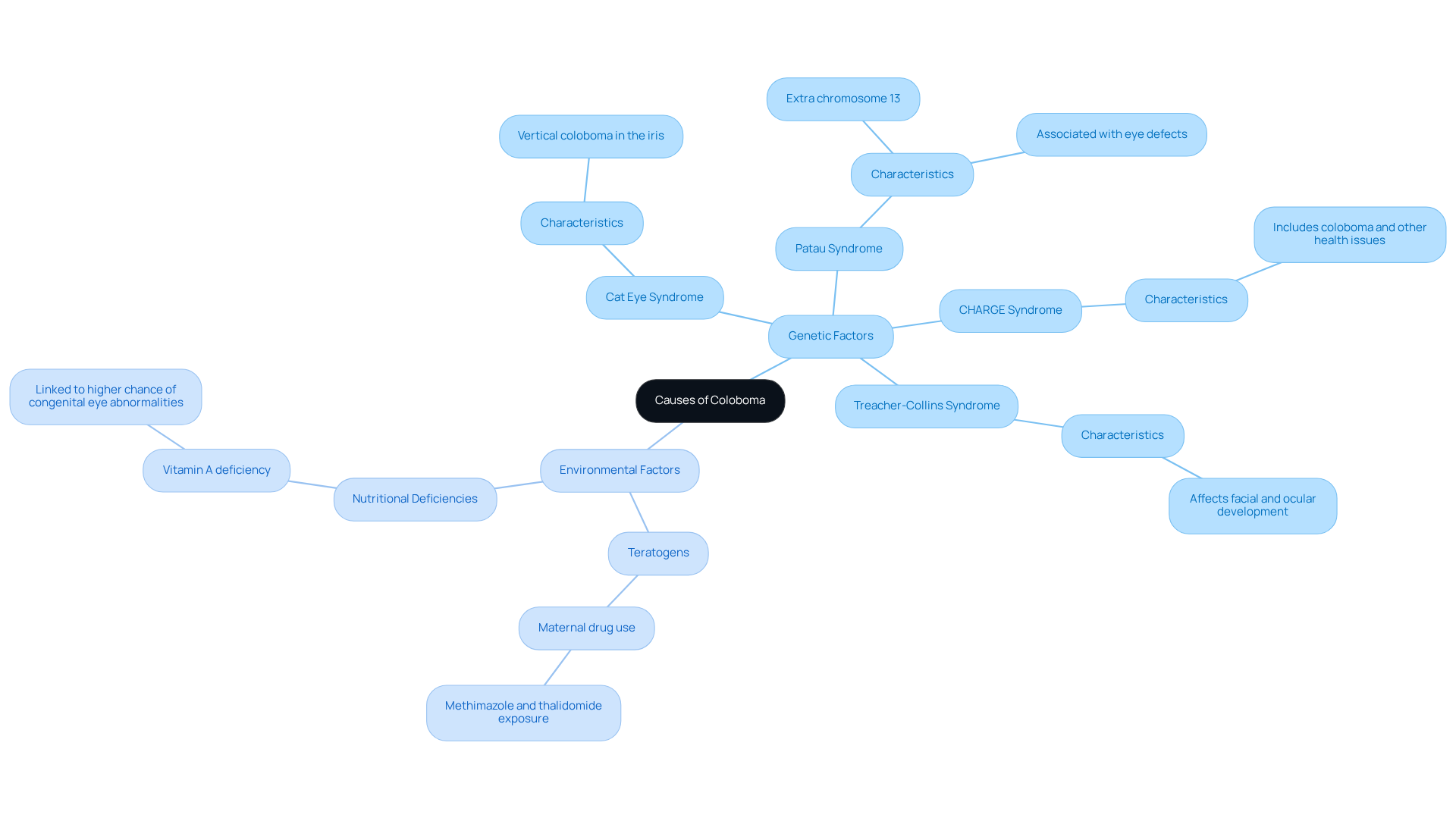
Examine Diagnosis: How Coloboma is Identified
Diagnosing an eye defect is a journey that requires a meticulous approach by an ophthalmologist. We understand that this process can be daunting, and it incorporates several key steps to ensure accurate identification and management of your condition.
- Medical History Review: This initial step gathers crucial information regarding your family history and any associated symptoms. Understanding these factors can provide valuable insights into potential genetic influences that may be at play.
- Visual Acuity Tests: These evaluations assess your sight, helping to identify the degree of any impairment caused by the eye defect. It’s common to feel anxious about these tests, but they are essential for your care.
- Dilated Eye Examination: By using eye drops to enlarge your pupils, ophthalmologists can perform a thorough assessment of your retina and optic nerve. This examination is vital for determining the specific type and extent of your eye condition.
- Imaging Tests: In certain cases, advanced imaging techniques such as Optical Coherence Tomography (OCT) are employed. These tests help visualize the internal structures of your eye more clearly, aiding in an accurate diagnosis.
Early diagnosis is crucial for managing potential complications associated with conditions like coloboma eye, which can include vision impairment or retinal detachment. Research shows that the average duration required for a definitive diagnosis can vary, but we want you to know that prompt action significantly improves outcomes for individuals. We recommend regular follow-ups and thorough evaluations to monitor any related ocular or systemic conditions, ensuring that you receive the best possible care. Remember, we are here to help you through this process.
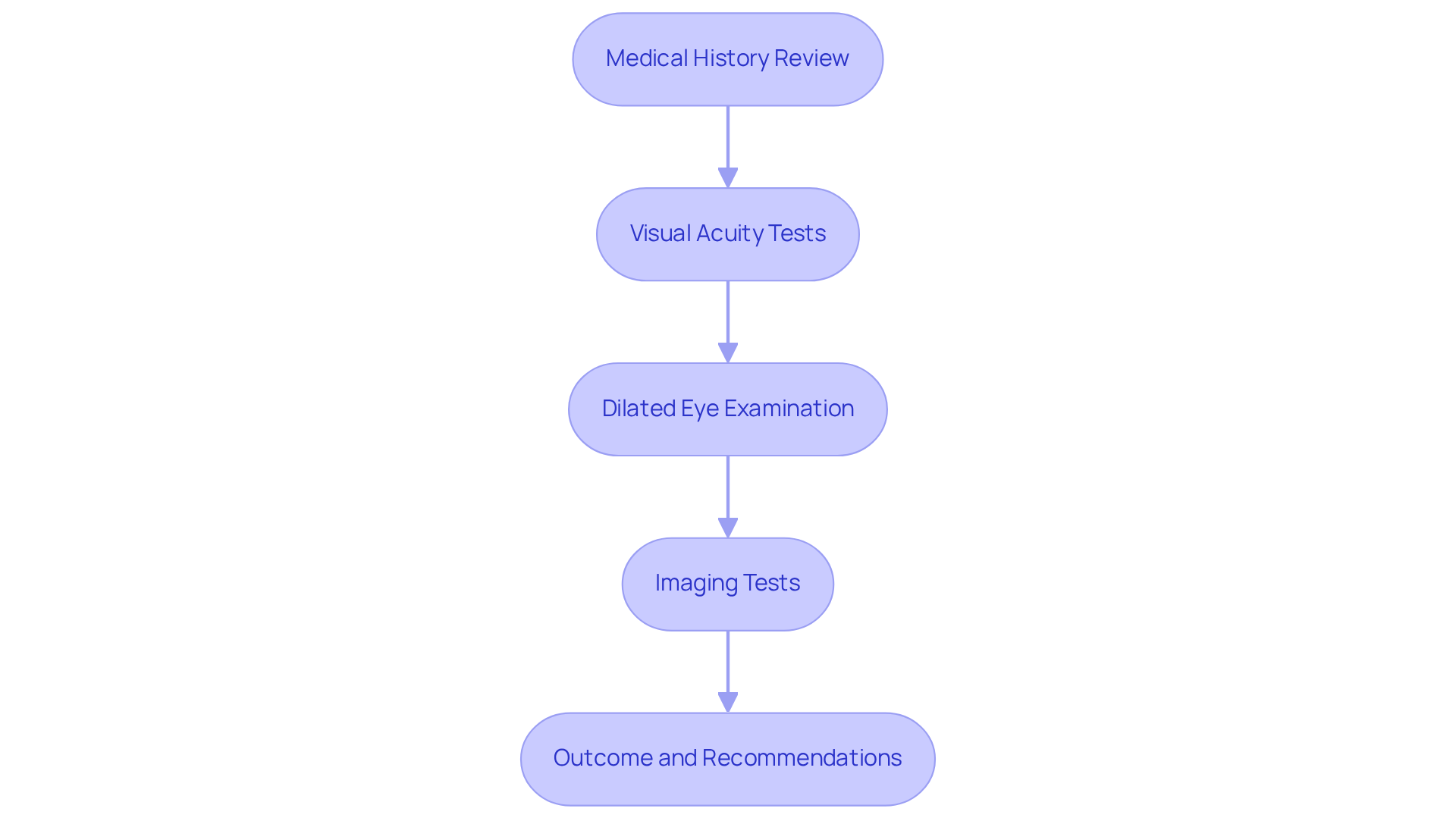
Review Treatment Options: Managing Coloboma Effectively
At present, we understand that this condition has no definitive cure, and treatment mainly focuses on managing symptoms and preventing complications. It’s important to know that there are key treatment options available to help you navigate this journey:
- Vision Correction: Prescription glasses or contact lenses can effectively address refractive errors associated with coloboma, enhancing visual clarity for many patients. This can make a significant difference in your daily life.
- Surgical Interventions: In some cases, surgical procedures may be necessary to improve the cosmetic appearance of the eye or to address complications such as retinal detachment. For instance, studies indicate that primary anatomical success in retinal detachment surgeries associated with chorioretinal coloboma is achieved in approximately 72.4% of cases, with complete retinal re-attachment in 93.1% of patients after surgical intervention. We know this can be a daunting prospect, but many have found success through these procedures.
- Low Vision Aids: For individuals facing considerable sight impairment, low vision aids can enhance remaining capabilities, enabling better daily functioning. Specialists can recommend devices tailored to your individual needs, ensuring you have the support necessary to thrive.
- Regular Monitoring: Ongoing eye examinations are crucial for tracking changes in vision and managing associated conditions like amblyopia or strabismus. Working together with a diverse group, including pediatric specialists and genetic advisors, can offer thorough support customized to the distinct challenges encountered by individuals with this eye condition.
In summary, while coloboma presents various challenges, we want you to know that effective management strategies and surgical interventions can significantly improve patient outcomes and quality of life. We are here to help you through this process.
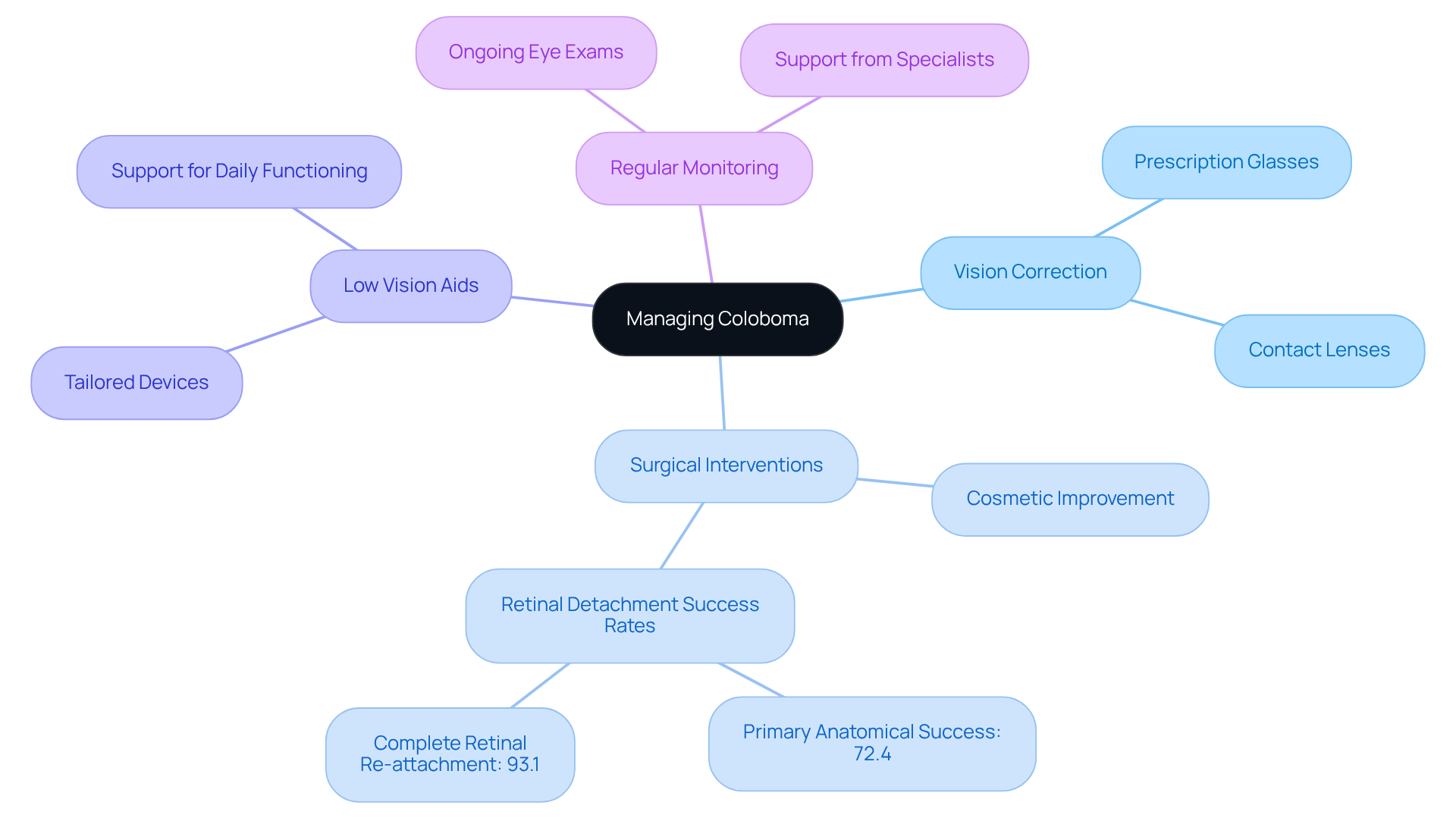
Conclusion
Coloboma eye is a complex congenital condition that affects various structures of the eye due to incomplete closure of the optic fissure during fetal development. We understand that learning about coloboma can be overwhelming, yet it is crucial to grasp its implications, as it can manifest in diverse ways, impacting vision and quality of life for those affected. The insights shared in this article provide a comprehensive overview of the symptoms, causes, diagnosis, and treatment options available for managing this condition.
Key points discussed include:
- The variety of symptoms associated with coloboma, ranging from light sensitivity to significant vision impairment.
- It’s common to feel anxious about these symptoms, but early diagnosis and continuous monitoring can significantly influence treatment outcomes.
- The genetic and environmental factors contributing to coloboma, underscoring the multifaceted nature of this condition.
In light of the information presented, we encourage individuals and families affected by coloboma to:
- Seek comprehensive eye assessments.
- Stay informed about the latest treatment options.
By understanding the complexities of coloboma, patients can better navigate their journey, advocate for their needs, and access the support required to enhance their quality of life. Awareness and education are powerful tools in managing this condition effectively, and we are here to help you through this process.
Frequently Asked Questions
What is coloboma?
Coloboma is a congenital condition characterized by the absence of normal tissue in one or more parts of the eye, affecting structures such as the iris, retina, choroid, or optic nerve. It occurs when the optic fissure fails to close completely during embryonic development.
How common is coloboma?
Coloboma occurs in about 1 in 5,000 live births, with a global prevalence ranging from 0.5 to 7.5 per 10,000 births. Approximately 67% of cases are unilateral, affecting one eye, while the remaining cases are bilateral, impacting both eyes.
What are the symptoms of coloboma?
Symptoms can vary depending on the specific eye structure affected and may include light sensitivity, a keyhole or cat-eye shaped pupil, vision impairment, nystagmus (involuntary eye movements), and other visual disturbances such as blurred sight or blind spots.
How does coloboma affect vision?
The impact on vision largely depends on the location and extent of the missing tissue. Some individuals may have good vision despite isolated iris anomalies, while others with more severe defects may experience significant visual impairment or total blindness in the affected eye.
What associated conditions are common with coloboma?
Associated conditions include strabismus (crossed eyes) and amblyopia (lazy eye), which affect approximately 30% and 33% of patients with coloboma, respectively.
How can coloboma be diagnosed?
Comprehensive eye assessments are crucial for detecting coloboma, especially in infants. Early diagnosis can greatly influence treatment outcomes.
What treatments are available for coloboma?
Treatment options depend on the severity and specific characteristics of the condition. Support and management strategies are available to help individuals cope with the symptoms and challenges associated with coloboma.






